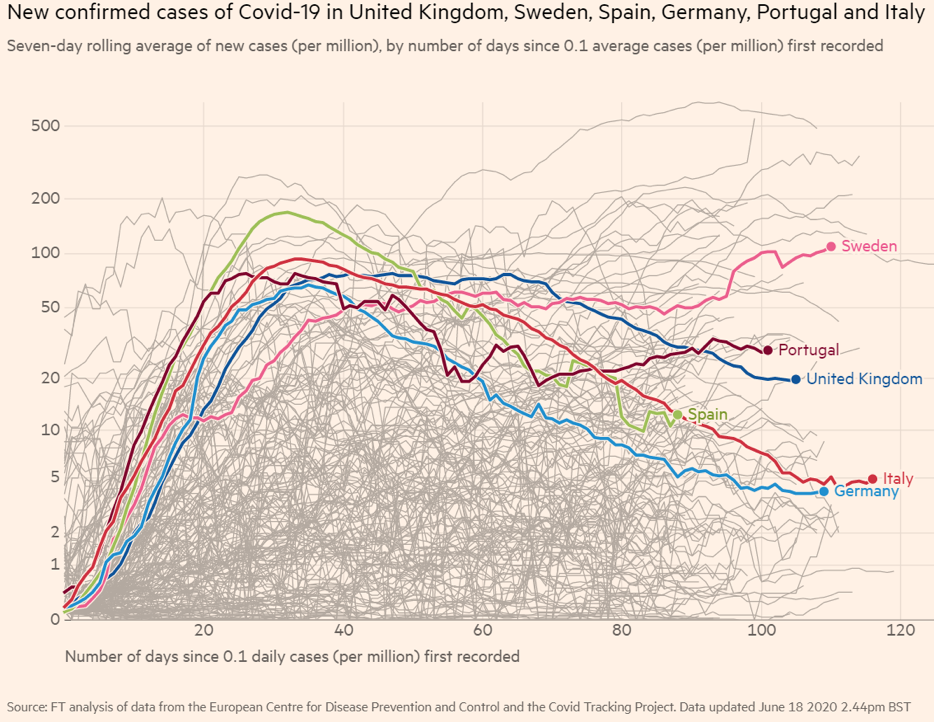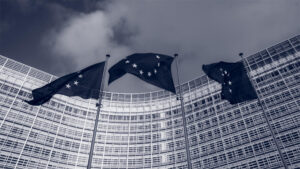You can also read the State of the Pandemic series’ take on the United States, Latin America, the Persian Gulf, East Asia and the BRICS.
There is no such thing as “Europe.” Yes, there’s this political-economic grouping called the EU, but two of Europe’s most important countries are not members. Yes, there’s this political-military grouping called NATO, but it is functionally run from a different hemisphere. Recent developments might – emphasis on might – change this, but the Europeans aren’t there yet.
With over 30 different political and decision-making systems, there is plenty of room to find fault with any broad assessment. But as regards the ongoing coronavirus pandemic, the fact remains that overall, Europe has been moving in the direction of fewer and fewer cases.

(Many, many thanks to the Financial Times for providing the data interface that makes this graphic possible. You can visualize your own data pulls here.)
The early phases of the epidemic were harsh in many places. In large part, it was because the Europeans had, at best incomplete information from which to base their policies. For the Italians and Spanish who suffered through coronavirus’ initial assault, they were simply caught off-guard. The result? Much of Europe enacted lockdowns whose intensity and airtight nature was only surpassed by the 1984-style lockdowns in Wuhan. (In Paris, you had to apply for a government permit to leave your home to shop for food. The permit only lasted for one hour.)
There’s also the issue of vectors. The suspected patient zero in Italy was initially misdiagnosed and so went from the hospital almost directly to a massive soccer game, becoming Europe’s first superspreader. Most people came to and left the game via bus, enabling the virus to spread liberally. A few of those buses went to Spain, which is why Spain became the second hardest-hit country in Europe.
In contrast, Austria and Germany’s superspreaders were a bunch of 20-somethings at ski parties in the Alps. The Austrians and Germans not only had a bit more warning than the Italians and Spaniards, but their epidemics were also among young millennials – a group that COVID doesn’t impact that harshly. The Austrians and Germans locked down their elderly populations, ran a rigorous testing and tracing program, and more or less nipped the problem in the bud.
Of course, despite caseloads moving in the right direction overall, this is not over. The variation of Europe’s COVID policies to date will also define the epidemic’s future:
Germany is playing it safe and has retained its de facto ban on all extra-European travelers until at least August 31st. Considering caseloads in the Western Hemisphere and the Middle East show no signs of dropping, expect this date to get pushed back.
In contrast, consider Portugal. Portugal is one of the many European countries suffering from a terminal demography; its birth rate crashed back in the late 1970s, never recovering, and the Portuguese economy is now a moribund mess. Since Portugal lacks the industrial base of a country like Germany, Portugal’s only growth sector is tourism. COVID killed tourism. Portugal recently released all restrictions in a desperate attempt to forestall what threatens to be an unending economic depression…which means Portugal is one of only three EU countries where caseloads are increasing.
Nor did everyone in Europe follow even remotely similar lockdown protocols. As mentioned earlier, the Europeans were working with incomplete information as the pandemic started, and not everyone came to the same conclusions. The British and Swedes balked at the economic damage full lockdowns would cause, and reasonably believed any effective vaccine would not be available for years. Add in that coronavirus has the highest infection rate of any public health threat since measles and a fairly low mortality rate, and both governments felt containment was a fools’ errand. They opted for management. Both decided to pursue herd immunity in an attempt to build a firewall against the virus within their populations.
Britain ultimately blinked, largely due to the carnage being wrecked in Italy which suggested much higher death counts than initially suspected. The Brits belatedly followed a more traditional lockdown approach. The delay landed the Brits with one of Europe’s highest infection rates as well as a lengthy plateau. It was only in mid-May that the Brits finally got COVID cases bending downward. The Swedes, on the other hand, stuck with the plan. Sweden now faces infection rates among the world’s highest, recently surpassing even the United States.
The real tragedy in Sweden was that knowing what we all knew back in April, the herd immunity strategy wasn’t silly, but instead a calculated risk. The Swedes assumed a functional vaccine would remain unavailable for years, and so concluded that building immunity within the population was the only sustainable route forward. Now it appears a functional vaccine will be available before the end of 2020, with mass distribution beginning (although not being completed) in 2021. The facts as we understand them have changed. Sweden’s sacrifice may have been for nothing.
If you enjoy our free newsletters, the team at Zeihan on Geopolitics asks you to consider donating to Feeding America.
The economic lockdowns in the wake of COVID-19 left many without jobs and additional tens of millions of people, including children, without reliable food. Feeding America works with food manufacturers and suppliers to provide meals for those in need and provides direct support to America’s food banks.
Food pantries are facing declining donations from grocery stores with stretched supply chains. At the same time, they are doing what they can to quickly scale their operations to meet demand. But they need donations – they need cash – to do so now.
Feeding America is a great way to help in difficult times.
The team at Zeihan on Geopolitics thanks you and hopes you continue to enjoy our work.








